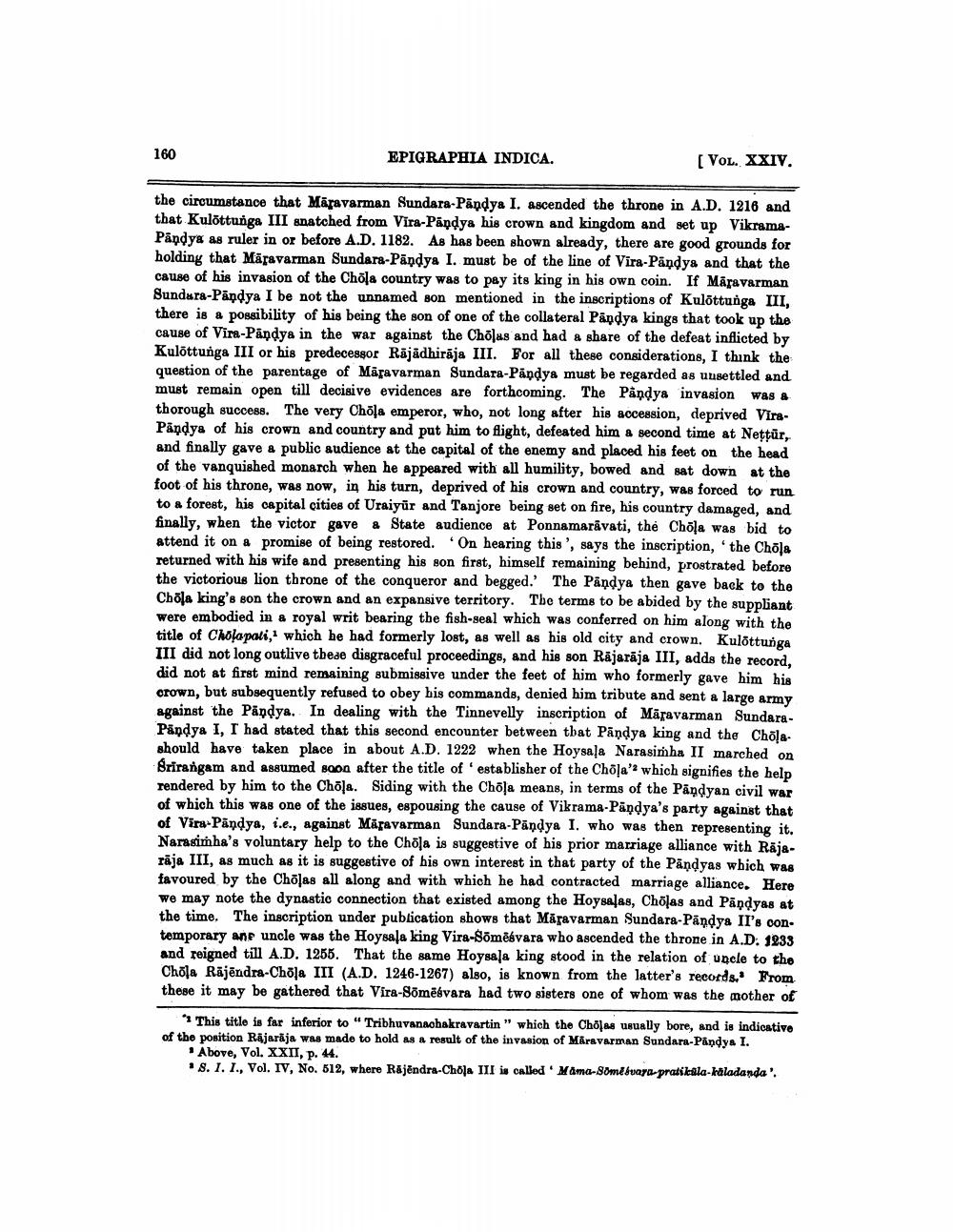________________
160
EPIGRAPHIA INDICA.
[Vol. XXIV.
the circumstance that Māravarman Sundara-Pāndya I. ascended the throne in A.D. 1216 and that Kulöttunga III snatched from Vira-Pandya his crown and kingdom and set up VikramaPandya as ruler in or before A.D. 1182. As has been shown already, there are good grounds for holding that Māravarman Sundara-Pandya I. must be of the line of Vira-Pandys and that the cause of his invasion of the Chola country was to pay its king in his own coin. If Māravarman Sundara-Pandya I be not the unnamed son mentioned in the inscriptions of Kulottunga III, there is a possibility of his being the son of one of the collateral Pandya kings that took up the cause of Vira-Pandya in the war against the Cholas and had a share of the defeat inflicted by Kulõttunga III or his predecessor Rajadhirāja III. For all these considerations, I think the question of the parentage of Māravarman Sundara-Pandys must be regarded as unsettled and must remain open till decisive evidences are forthcoming. The Pandya invasion was a thorough success. The very Chola emperor, who, not long after his accession, deprived ViraPandya of his crown and country and put him to flight, defeated him a second time at Netgūr, and finally gave a public audience at the capital of the enemy and placed his feet on the head of the vanquished monarch when he appeared with all humility, bowed and sat down at the foot of his throne, was now, in his turn, deprived of his crown and country, was forced to run to a forest, his capital cities of Uraiyur and Tanjore being set on fire, his country damaged, and finally, when the victor gave a State audience at Ponnamarāvati, the Chola was bid to attend it on a promise of being restored. On hearing this', says the inscription, the Chola returned with his wife and presenting his son first, himself remaining behind, prostrated before the victorious lion throne of the conqueror and begged.' The Pandya then gave back to the Chõla king's son the crown and an expansive territory. The terms to be abided by the suppliant were embodied in a royal writ bearing the fish-seal which was conferred on him along with the title of Chola pali, which he had formerly lost, as well as his old city and crown. Kulõttunga III did not long outlive these disgraceful proceedings, and his son Rājarāja III, adds the record, did not at first mind remaining submissive under the feet of him who formerly gave him his crown, but subsequently refused to obey his commande, denied him tribute and sent a large army against the Pandya. In dealing with the Tinnevelly inscription of Māravarman Sundara - Pandya I, I had stated that this second encounter between that Pandya king and the Cholashould have taken place in about A.D. 1222 when the Hoysaļa Narasimha II marched on Srirangam and assumed soon after the title of 'establisher of the Chola' which signifies the help rendered by him to the Chola. Siding with the Chola means, in terms of the Pandyan civil war of which this was one of the issues, espousing the cause of Vikrama-Pandya's party against that of Vira-Pandya, i.e., against Märavarman Sundara-Pandya I, who was then representing it. Narasimha's voluntary help to the Chola is suggestive of his prior marriage alliance with Rājarāja III, as much as it is suggestive of his own interest in that party of the Pandyas which was favoured by the Cholas all along and with which he had contracted marriage alliance. Here we may note the dynastic connection that existed among the Hoysalas, Cholas and Pandyas at the time. The inscription under publication shows that Māravarman Sundara-Pandya Il's contemporary and uncle was the Hoysala king Vira-Somē vara who ascended the throne in A.D. 1233 and reigned till A.D. 1255. That the same Hoysala king stood in the relation of uncle to the Chola Rājēndra-Chöja III (A.D. 1246-1267) also, is known from the latter's records. From these it may be gathered that Vira-Sõmēsvara had two sisters one of whom was the mother of
This title is far inferior to "Tribhuvanaohakravartin " which the Cholas usually bore, and is indicative of the position Rajaraja was made to hold as a result of the invasion of Maravarman Sundara-Pandya I.
* Above, Vol. XXII, p. 44. .8. 1. I., Vol. IV, No. 512, where Rajendra-Chola III is called 'Mama-Somesuara-pratikala-kaladanda'.




